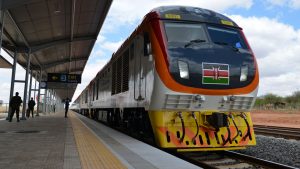According to recent official statistics the revenue which was generated by the Standard Gauge Railway (SGR) in Kenya from its passenger service and cargo service, increased by 33 percent in the six (6) months up until June 2021 (January 2021 to June 2021).

The growth is as a result of the country’s economy experiencing a major recovery.
According to data by the Kenya National Bureau of Statistics (KNBS) the Standard Gauge Railway (SGR)’s cargo trains and passenger trains generated 7.936 billion Kenyan Shillings during the January 2021 to June 2021 period under review. This is significantly higher than the 5.963 billion Kenyan Shillings that was achieved during a similar period in 2020.
The Standard Gauge Railway (SGR) cargo trains contributed the largest to the increase in revenue by 1.5 billion Kenyan Shillings during the period. For its passenger trains, they experienced a growth of 470 million Kenyan Shillings.
The Standard Gauge Railway (SGR) also increased its passenger numbers and doubled it during the period under review. It posted a 38.3 percent increase in its cargo volumes, increasing its revenue growth at a point when road transport means along with air transport means were experiencing major decreases in their returns as a result of the containment and preventive measures that were put in place to effectively combat the still ongoing Coronavirus pandemic.
In the six (6) month period (January 2021 to June 2021) the Standard Gauge Railway (SGR) achieved a total of 764,942 passengers. This indicated an increase of 133.8 percent from the total of 327, 097 passengers that was the case during a similar period in 2020.
According to Business Daily Africa, the Standard Gauge Railway (SGR)’s boost in passenger numbers occurred during the Easter holidays as it normally results in thousands of individuals traveling to Kenya’s costal destination that is Mombasa. This means said period becomes a very lucrative season for the Standard Gauge Railway (SGR).

The Standard Gauge Railway (SGR) operates it very own express train which commutes from Nairobi to Mombasa as well as an inter county service which carries out stops at the Voi Station, Mariakani station, the Miasenyi station, Mtito Andei Station, Kibwezi Station, Emali Station, and the Athi River Station.
In February of 2021 the freight charges were reduced by the Kenya Railways Corporation from 600 United States Dollars (which when converted is around 65,760 Kenyan Shillings) to 510 United States Dollars (which when converted is around 55,896 Kenyan Shillings) per each 20 foot container, and from 850 United States Dollars (which when converted is around 93,160 Kenyan Shillings) to 725 United States Dollars (which when converted is around 79,460 Kenyan Shillings) per each 40 foot container moving from Mombasa to Naivasha. The decision resulted in an increase in cargo volumes.
Africa Star Railway Operation Company which is more commonly known as Afristar and is the establishment in charge of all Standard Gauge Railway (SGR) operations, made it known that the total amount of containers that were transported via the trains had experienced an increase of almost half in the first month after when the freight charges were reduced.
The Africa Star Railway Operation Company has in addition, launched the loading of the bulk cargo on its special Open Type Wagons with the aim of attracting much more freight transactions.

During the period under review the Standard Gauge Railway (SGR) cargo trains ferried a total of 2.739 million tonnes which indicates a 38 percent increase from the 1.98 million tonnes that was ferried during a similar period when the Coronavirus pandemic was at its peak.
The Standard Gauge Railway (SGR) ferries the cargo from the Port of Mombasa to the Nairobi Container Depot which is deposited at Embakasi. Once there, said cargo is then transported by road to other parts of Kenya and the East African region at large.
The increased revenues of the Standard Gauge Railway (SGR) is occurring at a time when air transportation means and road transportation means experienced a reduction in usage due to lockdown restrictions as well as economic difficulties brought on by the still ongoing Coronavirus pandemic.
The overall revenues for the public transportation sector in Kenya, also experienced a significant drop in 2020 when Kenya first imposed the numerous measures aimed at combating the Coronavirus pandemic and its spread.

The air transport means and road transport means have since the pandemic hit, been subjected to carrying less than half of their passenger capacities in adherence to the preventive measures implemented by the Kenyan Government.
They have however now been allowed to go back to full capacity, since the beginning of August 2021.
Since 2020 Kenya’s national carrier; Kenya Airways also known as KQ has resulted to only using part of its entire fleet even when the domestic travel and international travel have been resumed. The decision has resulted in the carrier incurring major losses while also becoming heavily reliant on the Kenyan Treasury for funding.
Even with the Standard Gauge Railway (SGR)’s boost in revenue during the six (6) month period in review, it is still not making as much as its expenditure. Its operations have continued to cost taxpayers greatly, while being involved in the repaying of the loan used for the construction of the rail line and the purchasing of the wagons.
In 2020 the Kenyan Parliament stated that the East African nation of Kenya had not paid the sum of 38 billion Kenyan Shillings to the Africa Star Railway Operation Company which is majorly owned by the China Road and Bridge Corporation.
How informative was this article? Are there any other news topics, categories, or How To topics, that you would like us to write on? Feel free to reach out to Mpesa Pay in the comment section.


